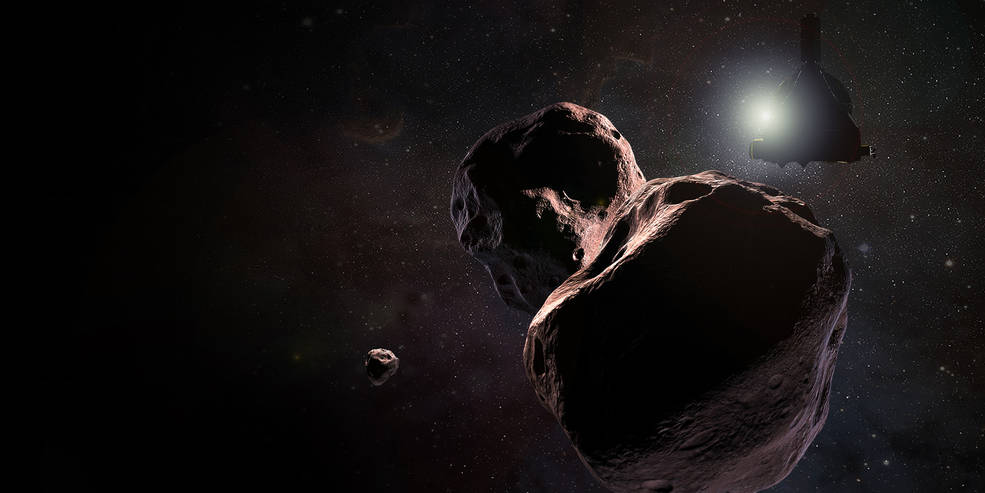New Horizons Spacecraft on Target for Superclose Flyby of Ultima Thule

NASA's New Horizons spacecraft will indeed get very close to the mysterious, distant object Ultima Thule on New Year's Day.
Mission principal investigator Alan Stern today (Dec. 18) gave the all-clear for New Horizons to stay on its optimal flyby course, which will take the probe within just 2,200 miles (3,500 kilometers) of Ultima Thule at 12:33 a.m. EST (0533 GMT) on Jan. 1.
The decision came after a nearly three-week search of New Horizons images for rings, moons or other debris near Ultima Thule that could pose a danger to the probe during the flyby, mission team members said. The detection of significant hazards could have spurred the team to divert New Horizons to a safer trajectory — one that would have taken the spacecraft about three times farther away from Ultima during the encounter. [NASA's New Horizons Mission in Pictures]
"Our team feels like we have been riding along with the spacecraft, as if we were mariners perched on the crow's nest of a ship, looking out for dangers ahead," hazards team leader Mark Showalter, of the SETI (Search for Extraterrestrial Intelligence) Institute in Mountain View, California, said in a statement. "The team was in complete consensus that the spacecraft should remain on the closer trajectory, and mission leadership adopted our recommendation."

The recent hazard hunt was capable of detecting any moons at least 2 miles (3.2 km) wide, and any ring structure that reflects at least 0.00005 percent of the sunlight falling on it, mission team members said.
The Ultima Thule flyby is the centerpiece of New Horizons' extended mission. The probe's prime mission focused on the first-ever flyby of Pluto, which New Horizons pulled off in July 2015, zooming within 7,800 miles (12,550 km) of the dwarf planet.
"The spacecraft is now targeted for the optimal flyby, over three times closer than we flew to Pluto," Stern, who's based at the Southwest Research Institute in Boulder, Colorado, said in the same statement. "Ultima, here we come!"
Get the Space.com Newsletter
Breaking space news, the latest updates on rocket launches, skywatching events and more!
Ultima Thule, which is officially known as 2014 MU69, lies about 1 billion miles (1.6 billion km) beyond Pluto. So, the New Year's flyby will be the most-distant planetary encounter in the history of spaceflight. And it should reveal key insights about the solar system's early days, because Ultima is a pristine, deep-frozen relic left over from the planet-formation period, mission team members have said.
It's a mysterious relic as well. Ultima appears to be reddish in color and about 23 miles (37 km) wide, but that's about all astronomers know about the object. Indeed, they aren't even sure if Ultima is a single body or a close-orbiting pair. We'll know a lot more after the flyby, of course.
And, if you want to send New Horizons some words of encouragement on encounter day, there's still time. You can arrange to beam a greeting to the far-flung probe through Friday (Dec. 21).
Go to http://pluto.jhuapl.edu/Send-Greetings/ to learn more.
Mike Wall's book about the search for alien life, "Out There" (Grand Central Publishing, 2018; illustrated by Karl Tate) is out now. Follow him on Twitter @michaeldwall. Follow us @Spacedotcom or Facebook. Originally published on Space.com.
Join our Space Forums to keep talking space on the latest missions, night sky and more! And if you have a news tip, correction or comment, let us know at: community@space.com.

Michael Wall is a Senior Space Writer with Space.com and joined the team in 2010. He primarily covers exoplanets, spaceflight and military space, but has been known to dabble in the space art beat. His book about the search for alien life, "Out There," was published on Nov. 13, 2018. Before becoming a science writer, Michael worked as a herpetologist and wildlife biologist. He has a Ph.D. in evolutionary biology from the University of Sydney, Australia, a bachelor's degree from the University of Arizona, and a graduate certificate in science writing from the University of California, Santa Cruz. To find out what his latest project is, you can follow Michael on Twitter.









